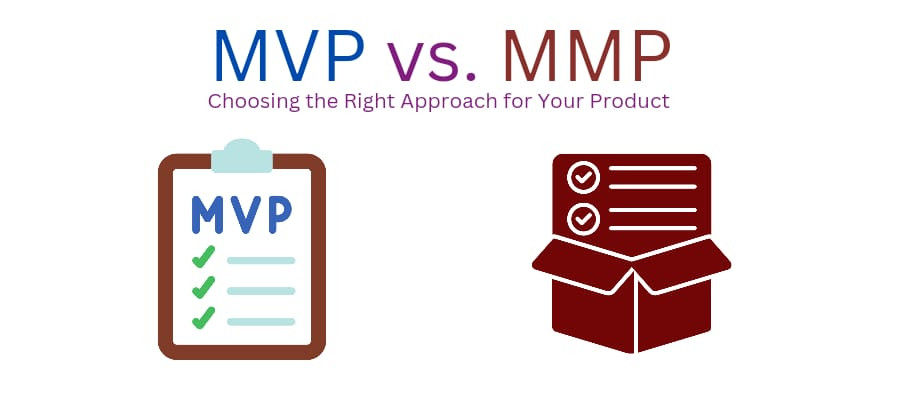MVP vs. MMP: Choosing the Right Approach for Your Product

Introducing a software product to the market can be overwhelming, particularly for startups and small enterprises. Numerous considerations exist, including product design, development timeline, and financial resources. Companies can adopt two popular approaches to bring their products to market successfully: the Minimum Viable Product (MVP) and the Minimum Marketable Product (MMP).
Imagine MVP and MMP as two complementary approaches. MVP, a prototype, enables you to test your product concept in the market by incorporating just enough features for validation. In contrast, MMP encompasses a comprehensive set of features and an appealing design that captivates customers.
This article will explore the distinctions between MVP and MMP, their respective benefits, and the situations in which each strategy aligns best with your business requirements.
What is a Minimum Viable Product?
The Minimum Viable Product (MVP) is a widely adopted practice in the modern IT industry, particularly for startups and product planning purposes. An MVP refers to a product that includes the minimum necessary features to attract early adopters and validate a product concept. It is rooted in the Lean Startup methodology, which emphasizes the significance of learning during the product development process.
The MVP iteration allows a team to gather the most valuable and validated customer data while minimizing the effort invested. In sectors like software development, an MVP enables the product team to swiftly gather customer feedback, iterate on the product, and enhance its functionality.
MVPs possess distinct characteristics that set them apart, including:
Limited functionality: MVPs are intentionally designed with a minimal set of features that are essential for addressing the core needs of early adopters. The focus is on delivering the critical functionality required to validate the product concept and gather valuable feedback. The MVP may lack certain features that would be present in the final product, as it aims to prioritize speed and learning over completeness.
Basic design: The design of an MVP is typically kept simple. The emphasis is on rapid development and getting the product to market quickly. The method may be functional rather than visually appealing, as the primary objective is to test the viability of the product idea and gather user feedback rather than to impress customers with an elaborate design.
Minimal marketing efforts: MVPs are often launched with minimal marketing efforts. The primary goal is to obtain feedback from early adopters and learn from their usage and experiences with the product. While some marketing activities may be undertaken to attract the target audience, the overall focus is on gaining insights and refining the product based on user feedback rather than creating a significant market impact.
What is a Minimal Marketable Product?
The Minimal Marketable Product (MMP) is a distinct product concept that follows the principle of "less is more." It refers to a product that includes only the essential features necessary to meet user demands, deliver the intended user experience, and effectively enter the market for sale.
The Minimum Marketable Feature (MMF) is another term that describes a minimum sellable product. An MMP is designed to enter the market with its core features and can be further expanded and developed to include additional "nice-to-have" features. The primary objective of an MMP is to reduce time-to-market, allowing it to be introduced more swiftly than a bulkier product with numerous features.
MMPs possess several distinct characteristics, which include:
Complete functionality: MMPs are developed with comprehensive features that provide full functionality to customers. This ensures that the product delivers tangible value and meets the target market's needs.
Attractive design: The design of an MMP is carefully crafted to be visually appealing and captivating to customers. The emphasis is on creating an aesthetically pleasing and user-friendly interface. The method of an MMP is more sophisticated and refined compared to that of an MVP.
Practical marketing efforts: MMPs are launched with a strong focus on marketing and promotion. The goal is to significantly impact the market and establish the product as a desirable offering.
Which is Best for You?
Validation Needs: If your primary goal is to quickly validate your product idea, gather user feedback, and iterate based on that feedback, MVP is a suitable choice. It allows you to test assumptions and validate your value proposition with minimal investment.
Time-to-Market: If speed is crucial and you want to enter the market quickly, MVP is a favorable option. It enables you to develop and launch a basic version of your product in a shorter timeframe than an MMP, which involves a more comprehensive feature set.
Resource Constraints: If you have limited resources, such as budget, development capacity, or time, MVP is a prudent choice. It allows you to focus on essential features, minimizing resource requirements and maximizing efficiency.
Marketability and Competitive Advantage: If your market research indicates a need for a more feature-rich product to compete effectively and capture customers' attention, an MMP may be the better option. It allows you to offer a complete product experience that meets customer expectations and stands out from competitors.
Wrapping Up
MVP and MMP are two widely embraced development strategies companies can employ to introduce their products to the market successfully. MVP is an ideal choice for businesses seeking rapid and cost-effective validation of their product idea. At the same time, MMP is well-suited for enterprises aiming to bring a marketable product.
Reference
- https://www.imaginarycloud.com/blog/mvp-vs-mmp/
- https://chisellabs.com/blog/guide-to-mvp-and-mmp/



